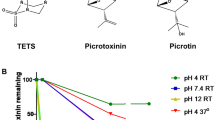Summary
The antiepileptic barbexaclone is the salt of the base propylhexedrine (indirect sympathomimetic) and phenylethylbarbituric acid. After i.v. and oral administration of 66 mg/kg barbexaclone to mice the time course of propylhexedrine and phenobarbital concentrations was studied in plasma, brain, lung, liver, kidney, spleen, heart, and skeletal muscle. Furthermore, the kinetics of phenobarbital were studied after treatment with an equimolar dose of phenobarbital-Na (40 mg/kg).
In contrast to the i.v. bolus of phenobarbital-Na, barbexaclone was non-lethal only when infused over a period of 3 min. After the i.v. administration of either salt, phenobarbital plasma levels declined monoexponentially with a half-life of 7.5 h; the volume of distribution was 0.78l/kg. After oral application absorption of phenobarbital was complete with both salts, though it was delayed after barbexaclone. The latter was the result of a delayed gastro-intestinal passage. Brain uptake of phenobarbital was a slow process, equilibrium with plasma concentrations being reached only 30 min after injection. Propylhexedrine reduced phenobarbital concentrations in brain as evident from steady state tissue-plasma ratios. This was observed after i.v. as well as after oral application.
After i.v. application of barbexaclone the following pharmacokinetic parameters for propylhexedrine were determined: t 0.5α 0.31 h, t 0.5β 2.5h, Vdβ 19.3l/kg; bioavailability (AUC oral/AUC i.v.) 0.37. Propylhexedrine penetrated the blood-brain barrier rapidly. High but unequal tissue accumulation was observed: lung=kidney>liver=brain>spleen >heart>skeletal muscle.
Similar content being viewed by others
References
Anderson RJ, Garza HR, Garriott JC, Dimaio V (1979) Intravenous propylhexedrine (benzedrex) abuse and sudden death. Am J Med 67:15–20
Appel W, Sprengard D (1971) Zur Pharmakokinetik von Propylhexedrine. Arzneimittelforsch 21:894–899
Axelrod J (1954) Studies on sympathomimetic amines: II. The biotransformation and physiological disposition of d-amphetamine, d-p-hydroxyamphetamine and d-methamphetamine. J Pharmacol Exp Ther 110:315–326
Becker B (1968) Erfahrungen mit dem Antiepileptikum Maliasin. Med Welt 19:557–580
Beckett AH, Rowland M (1965) Urinary excretion kinetics of amphetamine in man. J Pharm Pharmacol 17:628–639
Bragatti JH, Caleffi GH, Prenna FJ (1977) Ensaio clinico com um novo anti-epiléptico (barbexaclone). Arq Neuropsiquiat (S Paulo) 35: 277–281
Canger R, Wahl L (1968) Die Behandlung der Epilepsie mit Maliasin. Nervenarzt 39:476–478
Carlsson C, Hägerdal M, Siesjö BK (1975) Influence of amphetamine sulphate on cerebral blood flow and metabolism. Acta Physiol Scand 94:128–129
Dick RW, Mitchell CL (1967) A comparison of the anticonvulsant properties of l-propylhexedrine, phenobarbital and a salt-like complex of l-propylhexedrine and phenobarbital in mice and rats. Arch Int Pharmacodyn 170:333–342
Ferngren H (1969) Brain and blood levels of phenobarbital-2-14C during postnatal development in the mouse. Acta Pharmacol Suec 6:331–338
Frey HH, Kampmann E (1965) Tolerance to anticonvulsant drugs. Acta Pharmacol (Kbh) 22:159–171
Frey HH, Kampmann E (1966) Interaction of amphetamine with anticonvulsant drugs. II. Effect of amphetamine on the absorption of anticonvulsant drugs. Acta Pharmacol (Kbh) 24:310–316
Haas H (1963) Der Wirkungsmechanismus des l-1-Cyclohexyl-2-methylaminopropan-5,5-phenylaethyl-barbiturats und seine Eignung als Antiepilepticum. Arzneimittelforsch 13:613–624
Klissiunis N, Varonos D, Tzitzi F (1965) Wirkung des Amphetamins auf die Pentobarbitalkonzentration des Blutes bei oraler Darreichung. Naunyn-Schmiedeberg's Arch Exp Pathol Pharmakol 250:236–237
Krüger HJ, Schwarz H (1965) Klinische Mitteilung zur Epilepsie-Therapie mit Maliasin. Med Welt 14:690–692
Loo JCK, Riegelman S (1970) Assessment of pharmacokinetic constants from post-infusion blood curves obtained after i.v. infusion. J Pharm Sci 59:53–55
Marsden P, Sheldon J (1972) Acute poisoning by propylhexedrine. Br Med J 1:730
Masuda Y, Utsui Y, Shiraishi Y, Karasawa T, Yoshida K, Shimizu M (1979) Relationships between plasma concentrations of diphenylhydantoin, phenobarbital, carbamazepine, and 3-sulfamoylmethyl-1,2-benzisoxazole (AD-810), a new anticonvulsant agent, and their anticonvulsant or neurotoxic effects in experimental animals. Epilepsia (Amst) 20:623–633
Oliviera C, Fernandes I, Mauro de Lima J, Musse R (1977) Ensaio clinico com barbexaclone nas epilepsias. Arq Neuro-Psiquiat (S Paulo) 35:65–72
Paulson OB, Györy A, Hertz MM (1982) Blood-brain barrier transfer and cerebral uptake of antiepileptic drugs. Clin Pharmacol Ther 32:466–477
Penin H (1964) Wirkung und Indikation eines neuen Antiepilepticums. Dtsch Med Wschr 89:1683–1690
Radzialowski FM, Bousquet WF (1968) Daily rhythmic variation in hepatic drug metabolism in the rat and mouse. J Pharmacol Exp Ther 163:229–238
Remmer H, Siegert M (1962) Kumulation und Elimination von Phenobarbital. Naunyn-Schmiedeberg's Arch Exp Pathol Pharmakol 243:479–494
Russel J, Bass P, Goldberg LI, Schuster CR, Merz H (1982) Antagonism of gut, but not central effects of morphine with quaternary narcotic antagonists. Eur J Pharmacol 78:255–261
Schiefer I, Breyer FJ, Scheffner D (1968) Erfahrungen mit Maliasin bei der Behandlung anfallskranker Kinder. Med Welt 19:2420–2424
Schmidt D, Kupferberg HJ, Yonekawa W, Penry JK (1980) The development of tolerance to the anticonvulsant effect of phenobarbital in mice. Epilepsia (Amst) 21:141–147
Setnikar I, Temelcou O (1962) Effect of temperature on toxicity and distribution of pentobarbital and barbital in rats and dogs. J Pharmacol Exp Ther 135:213–222
Sotaniemi E (1967) The influence of environmental temperature on the concentration of pentobarbital and barbital in the liver and brain. Acta Pharmacol (Kbh) 25 (Suppl 5):1–63
Waddel WJ, Butler TC (1957) The distribution and excretion of phenobarbital. J Clin Invest 36:1217–1226
Author information
Authors and Affiliations
Rights and permissions
About this article
Cite this article
Iven, H., Feldbusch, E. Pharmacokinetics of phenobarbital and propylhexedrine after administration of barbexaclone in the mouse. Naunyn-Schmiedeberg's Arch. Pharmacol. 324, 153–159 (1983). https://doi.org/10.1007/BF00497022
Received:
Accepted:
Issue Date:
DOI: https://doi.org/10.1007/BF00497022




